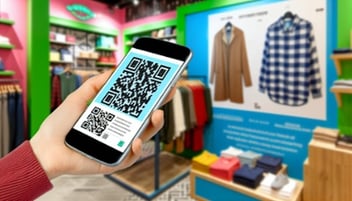
Listen to this blog
How Room & Board Measures In-Store Engagement
In the ever-evolving landscape of retail marketing, brands seek innovative ways to connect with their audience, enhance customer experiences, and measure the effectiveness of their strategies with precision. Today QR codes play a big role in how consumers can get more information in stores; that part is obvious. What's not so obvious is insights you can uncover with the data you gather based on their interactions.
Bridging the Digital and Physical Worlds
The integration of QR codes in retail environments is not just a trend; it's a transformative strategy that bridges the gap between physical and digital experiences. By placing QR codes on in-store signage or directly on products, retailers offer customers a seamless way to access detailed product information, immersive experiences, and even special offers—all with a simple scan using their smartphones. For Room & Board, they manage the links behind the QR codes with BL.INK, so they can capture unlimited data from every scan and click.
This strategy does more than just provide convenience; it leverages the power of structured data to deliver personalized experiences that resonate with today's tech-savvy consumers. The result? A deeper engagement that drives loyalty and sales, and reporting that captures in-store campaign performance.
The Magic of Marketing Attribution Reporting
One of the most significant challenges in marketing has always been attributing sales to specific campaigns accurately. By tracking interactions with QR codes and custom links, retailers can see exactly when and where shoppers engaged with their campaigns in stores, just like they do for digital campaigns. For example, let's say a retailer creates specific links that appear on physical, in-store signage and on products. The data from each scan or click can identify which store they're in, where in the store they are, and which campaign or product they scanned. What's more, based on this information, the retailer can use rules-based link routing to deliver a specific experience based on the shopper's language preference and location.
This data-driven approach allows for refined marketing attribution reporting, enabling brands to understand which strategies are driving real results and which need rethinking. It's not just about tracking clicks; it's about understanding the journey from discovery to purchase and optimizing every step of that journey.
Case Study: A Furniture Retailer's Success Story
Consider the success story of a furniture retailer that implemented QR codes and custom links across their marketing channels. By embedding QR codes tied to short links in their in-store signage and digital advertising, they not only made it easier for customers to access detailed product information and reviews but also seamlessly integrated their online and offline experiences.
The results were clear: an increase in customer engagement, higher conversion rates, and detailed marketing attribution reports that guided their future strategies. This approach turned casual browsers into informed purchasers, significantly impacting the bottom line. And they have the data to prove it. Read the full case study here.
The Role of QR Code Generation and Link Management
Effective use of QR codes and links requires more than just the technology itself; it demands a strategic approach to QR code generation and link management. BL.INK offers businesses the ability to create, manage, and track QR codes and custom links with ease, providing a wealth of data for marketing analysis and decision-making.
And this data is structured, meaning it uses consistent naming conventions, includes specific data points that the company wants to track, and always delivers complete attribution data. So the data is unassailable. Everyone from marketing to the executive team is now aligned on marketing data, what it means, and how it's used.
By understanding which links are generating the most traffic and engagement, Room and Board is continuously refining their strategies, ensuring that they're always using the most effective channels and messages to reach their audience.
The Future of Retail Marketing
The integration of QR codes and link management into retail marketing strategies represents a significant shift towards more interactive, personalized, and data-driven customer experiences.
As businesses continue to explore the possibilities of these technologies, we can expect to see even more innovative applications that not only enhance the customer journey but also provide brands with the insights needed to succeed in a competitive marketplace.
For example, today's manufacturers can attach a QR code to every product they sell. When they use BL.INK, they can easily capture product information, supply chain information, materials and source information, purchase location, and more, creating a digital product passport of sorts. They can capture location and time, date, and language preference of the phone that scanned the code, and more. These links act as a library of each product, with specific details attached to every one. And as materials or sources change, the data is always editable within BL.INK.
For those looking to dive deeper into the transformative impact of QR codes and link management on customer engagement, we invite you to download the full Room and Board case study. Discover all the ways they're using BL.INK link management to drive growth and innovation, streamlining work, and gaining credibility in their marketing efforts.
Ready to revolutionize your marketing strategy and unlock new levels of engagement and insight? Learn more about how BL.INK can help you achieve your goals by scheduling a meeting with us today. Together, let's redefine the future of retail marketing.



